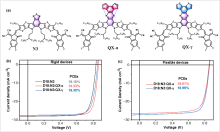 06/27/2023Researchers Unveil Enhanced Oxygen Reduction Reaction Activity and Biperiodic Trends of Lanthanide-Doped Molybdenum Disulfide
06/27/2023Researchers Unveil Enhanced Oxygen Reduction Reaction Activity and Biperiodic Trends of Lanthanide-Doped Molybdenum Disulfide
A research group led by Prof. WANG Liping at the Ningbo Institute of Materials Technology and Engineering (NIMTE) of Chinese Academy of Sciences (CAS) has unveiled the enhanced oxygen reduction reaction (ORR) activity and biperiodic chemical trends of lanthanide-doped molybdenum disulfide (Ln-MoS2). The study was published in Nature Communications.
 06/20/2023Isomerization Strategy on Non-fullerene Guest Acceptor Enables Stable High-Efficiency Organic Solar Cells
06/20/2023Isomerization Strategy on Non-fullerene Guest Acceptor Enables Stable High-Efficiency Organic Solar Cells
A research group led by Prof. GE Ziyi at the Ningbo Institute of Materials Technology and Engineering (NIMTE) of the Chinese Academy of Sciences (CAS), has developed two isomeric non-fullerene acceptors and doped them into the D18:N3-based binary organic solar cells (OSCs) as a third component, resulting in highly efficient rigid and flexible ternary OSCs with the power conv...
 06/19/2023Hybrid Cathode Enables Scalable High-Performance Hydrogen Generation
06/19/2023Hybrid Cathode Enables Scalable High-Performance Hydrogen Generation
A research group led by Prof. LU Zhiyi at the Ningbo Institute of Materials Technology and Engineering (NIMTE) of Chinese Academy of Sciences (CAS), has proposed a facile and cost-effective strategy to synthesize a hybrid cathode, achieving high-performance seawater electrolysis for hydrogen generation. The study was published in Advanced Functional Materials.
 06/02/2023Scientists Detect Exponential Relaxation Spectrum in Glasses
06/02/2023Scientists Detect Exponential Relaxation Spectrum in Glasses
Prof. Wang Junqiang’s team at the Ningbo Institute of Materials Technology and Engineering (NIMTE) of the Chinese Academy of Sciences (CAS), has revealed the exponential relaxation events during the recovery process of glasses, providing a solid evidence that non-exponential relaxation peaks in glasses are composed of series of exponential relaxation units. The study was pu...
 05/22/2023Novel Multicolor Fluorescent Hydrogel System Developed for On-Demand Information Display
05/22/2023Novel Multicolor Fluorescent Hydrogel System Developed for On-Demand Information Display
The Smart Polymer Materials group led by Prof. CHEN Tao at the Ningbo Institute of Materials Technology and Engineering (NIMTE) of Chinese Academy of Sciences (CAS), has developed a flexible near-infrared (NIR) light-writing multicolor hydrogel system for on-demand information display. The study was published in Advanced Materials.